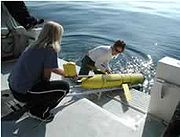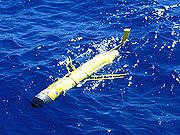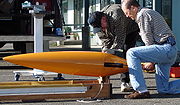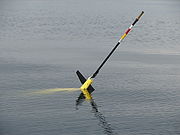
Underwater gliders
Encyclopedia




Autonomous Underwater Vehicle
An autonomous underwater vehicle is a robot which travels underwater without requiring input from an operator. AUVs constitute part of a larger group of undersea systems known as unmanned underwater vehicles, a classification that includes non-autonomous remotely operated underwater vehicles...
(AUV) that uses small changes in its buoyancy
Buoyancy
In physics, buoyancy is a force exerted by a fluid that opposes an object's weight. In a column of fluid, pressure increases with depth as a result of the weight of the overlying fluid. Thus a column of fluid, or an object submerged in the fluid, experiences greater pressure at the bottom of the...
in conjunction with wings to convert vertical motion to horizontal, and thereby propel itself forward with very low power consumption. While not as fast as conventional AUVs, gliders using buoyancy-based propulsion represent a significant increase in range and duration compared to vehicles propelled by electric motor
Electric motor
An electric motor converts electrical energy into mechanical energy.Most electric motors operate through the interaction of magnetic fields and current-carrying conductors to generate force...
-driven propeller
Propeller
A propeller is a type of fan that transmits power by converting rotational motion into thrust. A pressure difference is produced between the forward and rear surfaces of the airfoil-shaped blade, and a fluid is accelerated behind the blade. Propeller dynamics can be modeled by both Bernoulli's...
s, extending ocean sampling missions from hours to weeks or months, and to thousands of kilometers of range. Gliders follow an up-and-down, sawtooth
Sawtooth wave
The sawtooth wave is a kind of non-sinusoidal waveform. It is named a sawtooth based on its resemblance to the teeth on the blade of a saw....
-like profile through the water, providing data on temporal and spatial scales unavailable to previous AUVs, and much more costly to sample using traditional shipboard techniques.
History
The DARPA SBIR program received a proposal for a temperature gradient glider in 1988. DARPA was aware at that time of similar research projects underway in the USSR.The concept of the glider was introduced to the oceanographic community by Henry Stommel
Henry Stommel
Henry Melson Stommel was a major contributor to the field of physical oceanography. Beginning in the 1940s, he advanced theories about global ocean circulation patterns and the behavior of the Gulf Stream that form the basis of physical oceanography today...
in a 1989 article in Oceanography, when he proposed a glider concept called Slocum, developed with research engineer Doug Webb. They named the glider after Joshua Slocum
Joshua Slocum
Joshua Slocum was the first man to sail single-handedly around the world. He was a Canadian born, naturalised American seaman and adventurer, and a noted writer. In 1900 he told the story of this in Sailing Alone Around the World...
, who made the first solo circumnavigation of the globe by sailboat. They proposed harnessing energy from the thermal
Thermal
A thermal column is a column of rising air in the lower altitudes of the Earth's atmosphere. Thermals are created by the uneven heating of the Earth's surface from solar radiation, and are an example of convection. The sun warms the ground, which in turn warms the air directly above it...
gradient
Gradient
In vector calculus, the gradient of a scalar field is a vector field that points in the direction of the greatest rate of increase of the scalar field, and whose magnitude is the greatest rate of change....
between deep ocean water (2-4 °C) and surface water (near atmospheric temperature) to achieve globe-circling range, constrained only by battery power onboard for communications, sensors, and navigational computers.
By 2005, not only had a working thermal-powered glider (Slocum Thermal) been demonstrated by Webb Research (founded by Doug Webb), but they and other institutions had introduced battery-powered gliders with impressive duration and efficiency, far exceeding that of traditional survey-class AUVs. The University of Washington
University of Washington
University of Washington is a public research university, founded in 1861 in Seattle, Washington, United States. The UW is the largest university in the Northwest and the oldest public university on the West Coast. The university has three campuses, with its largest campus in the University...
Seaglider and Scripps Institution of Oceanography
Scripps Institution of Oceanography
Scripps Institution of Oceanography in La Jolla, California, is one of the oldest and largest centers for ocean and earth science research, graduate training, and public service in the world...
Spray vehicles have performed feats such as crossing the Gulf Stream
Gulf Stream
The Gulf Stream, together with its northern extension towards Europe, the North Atlantic Drift, is a powerful, warm, and swift Atlantic ocean current that originates at the tip of Florida, and follows the eastern coastlines of the United States and Newfoundland before crossing the Atlantic Ocean...
from the mainland USA to Bermuda, and, together with the Webb Slocum, conducting sustained, multi-vehicle collaborative monitoring of oceanographic variables in Monterey Bay
Monterey Bay
Monterey Bay is a bay of the Pacific Ocean, along the central coast of California. The bay is south of San Francisco and San Jose, between the cities of Santa Cruz and Monterey....
.
In 2011, the SeaExplorer vehicle is released, allowing multi-purpose missions by dedicating the entire first third of the vehicle to much larger payloads, in addition to typical CTDs. The vehicle is equipped with latest generation of externally-rechargeable Li-Ion batteries making refuiling fast, free, and safe. Last but not least, the vehicle glides without wings (only two pairs of static fins are used at the back for stability), making it extremely reliabale and robust during deployement, recovery and surfacing in operational conditions.
Originally conceived as testbed for the thermal-power gliders before developing into a platform of their own, the Webb Slocum electric gliders have been widely deployed since 2003. On December 4, 2009, one of these gliders, RU-27
RU-27
RU-27, dubbed Scarlet Knight after the Rutgers Scarlet Knights athletic teams, is an experimental American autonomous underwater vehicle – a modified Slocum Autonomous Underwater Gliding Vehicle – operated by Rutgers University oceanographers...
, became the first to complete a transatlantic journey, traveling from New Jersey to the coast of Spain in 221 days. The effort was led by a team from Rutgers University
Rutgers University
Rutgers, The State University of New Jersey , is the largest institution for higher education in New Jersey, United States. It was originally chartered as Queen's College in 1766. It is the eighth-oldest college in the United States and one of the nine Colonial colleges founded before the American...
, which has become one of the largest glider operators.
Functional Description
Gliders typically make measurements such as temperatureTemperature
Temperature is a physical property of matter that quantitatively expresses the common notions of hot and cold. Objects of low temperature are cold, while various degrees of higher temperatures are referred to as warm or hot...
, conductivity
Conductivity (electrolytic)
The conductivity of an electrolyte solution is a measure of its ability to conduct electricity. The SI unit of conductivity is siemens per meter ....
(to calculate salinity
Salinity
Salinity is the saltiness or dissolved salt content of a body of water. It is a general term used to describe the levels of different salts such as sodium chloride, magnesium and calcium sulfates, and bicarbonates...
), currents, chlorophyll
Chlorophyll
Chlorophyll is a green pigment found in almost all plants, algae, and cyanobacteria. Its name is derived from the Greek words χλωρος, chloros and φύλλον, phyllon . Chlorophyll is an extremely important biomolecule, critical in photosynthesis, which allows plants to obtain energy from light...
fluorescence
Fluorescence
Fluorescence is the emission of light by a substance that has absorbed light or other electromagnetic radiation of a different wavelength. It is a form of luminescence. In most cases, emitted light has a longer wavelength, and therefore lower energy, than the absorbed radiation...
, optical backscatter
Backscatter
In physics, backscatter is the reflection of waves, particles, or signals back to the direction they came from. It is a diffuse reflection due to scattering, as opposed to specular reflection like a mirror...
, bottom depth, and (occasionally) acoustic backscatter. They navigate with the help of periodic surface GPS fixes, pressure sensors, tilt sensors, and magnetic compasses. Vehicle pitch is controllable by movable internal ballast (usually battery packs), and steering is accomplished either with a rudder (as in Slocum) or by moving internal ballast to control roll (as in SeaExplorer, Spray and Seaglider). Buoyancy is adjusted either by using a piston
Piston
A piston is a component of reciprocating engines, reciprocating pumps, gas compressors and pneumatic cylinders, among other similar mechanisms. It is the moving component that is contained by a cylinder and is made gas-tight by piston rings. In an engine, its purpose is to transfer force from...
to flood/evacuate a compartment with seawater (Slocum) or by moving oil in/out of an external bladder (SeaExplorer, Seaglider, Spray, and Slocum Thermal). Commands and data are relayed between gliders and shore by satellite.
Gliders vary in the pressure they are able to withstand. The Slocum model is rated for 200 meter or 1000 meter depths. Spray can operate to 1500 meters, Seaglider to 1000 meters, SeaExplorer to 700, and Slocum Thermal to 1200. In August 2010, a Deep Glider variant of the Seaglider achieved a repeated 6000-meter operating depth.
XRay Flying Wing
As of 2006, the US Navy Office of Naval ResearchOffice of Naval Research
The Office of Naval Research , headquartered in Arlington, Virginia , is the office within the United States Department of the Navy that coordinates, executes, and promotes the science and technology programs of the U.S...
is developing the world's largest glider, the Liberdade XRay, which uses a blended wing body
Blended wing body
Blended Wing Body aircraft have a flattened and airfoil shaped body, which produces most of the lift, the wings contributing the balance. The body form is composed of distinct and separate wing structures, though the wings are smoothly blended into the body...
hullform to achieve hydrodynamic efficiency. It is intended to quietly track diesel electric submarines in littoral
Littoral
The littoral zone is that part of a sea, lake or river that is close to the shore. In coastal environments the littoral zone extends from the high water mark, which is rarely inundated, to shoreline areas that are permanently submerged. It always includes this intertidal zone and is often used to...
waters, remaining on station for up to 6 months, with major field testing beginning in August 2006.
See also
- AUV
- Argo floatsArgo (oceanography)Argo is an observation system for the Earth's oceans that provides real-time data for use in climate, weather, oceanographic and fisheries research. Argo consists of a large collection of small, drifting oceanic robotic probes deployed worldwide. The probes float as deep as 2 km. Once every...
- Paravane (weapon)Paravane (weapon)The paravane is a form of towed underwater "glider". It was developed by Cdr Usborne and Lt Burney financed by Sir George White, founder of the Bristol Aeroplane Company....
- Paravane (water kite)Paravane (water kite)]The paravane is a towed winged underwater object—water kite. Paravanes have been used in sport or commercial fishing, marine exploration and industry, sports and military. The wings of paravanes are sometimes in a fixed position, else positioned remotely or by actions of a human pilot...
- DeepFlight Super FalconDeepFlight Super FalconThe DeepFlight Super Falcon is a personal submarine designed by Graham Hawkes, a former civilian ocean engineer. It was hoped that the technology used in this submersible would allow travel to the deepest parts of the ocean.- Development :...
External links
- EGO network - glider user group
- Seaexplorer page at ACSA Underwater GPS
- Spray page at Scripps Institution of Oceanography
- Seaglider page at Applied Physics Laboratory - University of Washington
- Seaglider Operations page at APL-UW
- Rutgers University Coastal Ocean Observations Lab -- Glider Operations
- Slocum page at Webb Research Corp.
- Underwater glider configurations and details - AUVAC.org
- Underwater Gliders for Ocean Research
- Robot glider harvests ocean heat
- National Oceanography Centre, UK. Glider Home Page

